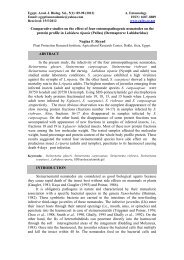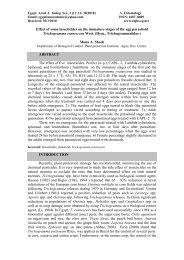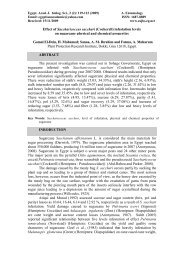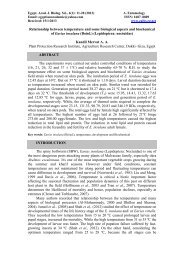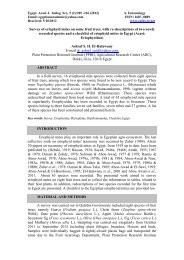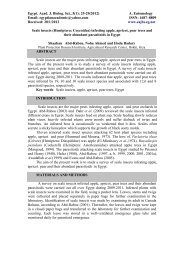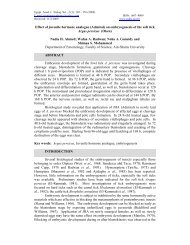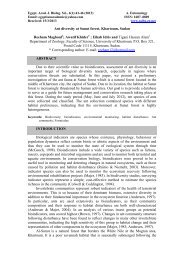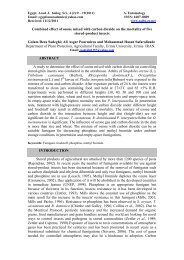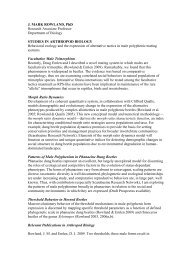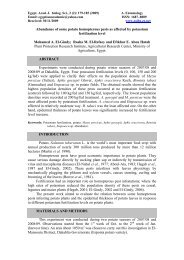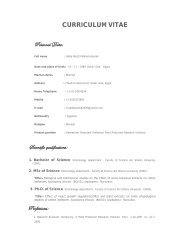Heat Requirements for the Development of the Black cutworm ...
Heat Requirements for the Development of the Black cutworm ...
Heat Requirements for the Development of the Black cutworm ...
You also want an ePaper? Increase the reach of your titles
YUMPU automatically turns print PDFs into web optimized ePapers that Google loves.
122<br />
Hassan F. Dahi et al.<br />
The three observed values <strong>for</strong> pre-oviposition rate <strong>of</strong> increase at rang <strong>of</strong><br />
temperature from 20 to 30C, gave also a remarkable good fit to <strong>the</strong> calculated<br />
temperature – velocity line having <strong>the</strong> <strong>for</strong>mula Y = 2.619 x - 28.96 (Fig.4).<br />
Fig. ( 4): The regression line <strong>of</strong> a<strong>the</strong> n d drelation i ffe r e n t c obetween n s t a n t t e m<strong>the</strong> p e rrate a t u r e<strong>of</strong> s . development <strong>of</strong> A. ipsilon<br />
pre-oviposition period and different constant temperatures.<br />
The generation<br />
The mean duration <strong>of</strong> generation at different constant temperature regimes<br />
could be calculated using <strong>the</strong> total <strong>of</strong> mean duration <strong>of</strong> different developmental<br />
stages (i.e. incubation period, larval stage, pupal stage and pre-oviposition period).<br />
Theoretically, <strong>the</strong> results obtained from are method showed an approximate value<br />
<strong>for</strong> mean duration <strong>of</strong> generation at different constant temperature regimes.<br />
In <strong>the</strong> present study, <strong>the</strong> data in Table (5) indicate that <strong>the</strong> mean duration <strong>of</strong><br />
generation <strong>for</strong> A. ipsilon was 61.59, 38.96 and 29.73days at 20, 25 and 30 C,<br />
respectively. Data revealed that <strong>the</strong> increasing <strong>of</strong> temperature accelerated <strong>the</strong><br />
developmental rate <strong>of</strong> A. ipsilon where it reached a maximum velocity at 30 C.<br />
Table (5): Duration <strong>of</strong> A. ipsilon generation under different constant temperatures and its <strong>the</strong>rmal<br />
requirements.<br />
Temp.<br />
(°C)<br />
R a te o f d e v e lo p(1/t m ex1 n t0<br />
0)<br />
Duration <strong>of</strong><br />
generation<br />
(days ± S.E)<br />
Expected<br />
duration (days)<br />
Rate <strong>of</strong><br />
increase<br />
%<br />
Expected<br />
rate <strong>of</strong><br />
increase %<br />
t o<br />
(˚C)<br />
Degree<br />
Days<br />
(DD΄s)<br />
20 61.59 ± 1.37 a 60.97 1.62 1.64<br />
583.3<br />
25 38.96 ± 0.94 b 39.84 2.57 2.51 10.53 563.8<br />
30 29.73 ± 0.66 c 29.58 3.36 3.38 578.8<br />
Average 575.3<br />
L.S.D 1.23<br />
5 0<br />
4 0<br />
3 0<br />
2 0<br />
1 0<br />
0<br />
r = 0 . 9 9 K = 3 8 . 1<br />
y = 2 .6 1 9 x - 2 8 .9 6<br />
0 5 1 0 1 5 2 0 2 5 3 0 3 5<br />
T e m p e ra t u re ( ° C)<br />
F i g . ( 4 ) : T h e r e g r e s s i o n l i n e o f t h e r e l a t i o n b e t w e e n t h e<br />
r a t e o f d e v e l o p m e n t o f A . i p s i l o n p r e - o v i p o s i t i o n p e r i o d<br />
The lower threshold <strong>of</strong> development (t 0) could be estimated graphically<br />
by extrapolation from Fig. (5), it was 10.53C and <strong>the</strong> average <strong>the</strong>rmal summation<br />
was 575.3 dd's.<br />
These results agreed with <strong>the</strong> findings obtained by Kajanshikov (1946)<br />
who found that <strong>the</strong> linear relationship between temperature and rate <strong>of</strong> development



